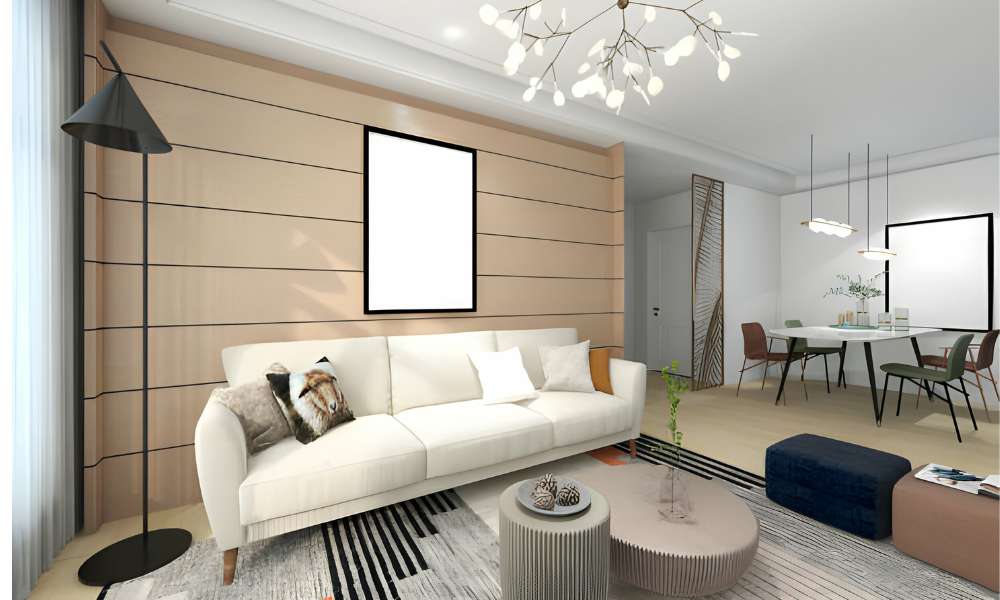Navigating the world Of interior design Can transform any living room into A harmonious sanctuary that reflects both style And functionality. Adhering to certain interior design rules For the living room not only enhances the aesthetic appeal but also ensures that the space is welcoming And comfortable. From selecting the right color palette To optimizing the layout For flow and functionality, these guidelines help create a cohesive look that ties together various elements. Whether you’re aiming for A modern minimalist vibe or A cozy, Eclectic feel, Understanding the basics Of interior design can elevate your living room, Making it the heart Of your home where memories are made and cherished.
1. Create a Focal Point
Every room needs a focal point, a central spot that draws the eye and gives the room a purpose. For a room, this is often the fireplace, a piece of art, or even a towering house plant. The focal point anchors the room and sets the tone for the design. Arrange furniture around this point to create a natural flow and embrace symmetry or asymmetry, depending on your aesthetic.
2. Play with Scale and Proportion
It’s crucial to balance the size of your furniture with the size. Large living can handle substantial pieces, while smaller spaces may need sleek, space-saving designs. Be mindful of the scale—mixing large, medium, and small-scale items can create visual interest. Additionally, make sure to allow for breathing so that people can move around comfortably without feeling claustrophobic or like they’re shouting to be heard.
3. Select a Cohesive Color Scheme
Your color scheme sets the mood of the space. Cool colors like blues, greens, and purples can create a calming feel, while warm colors like reds, oranges, and yellows are inviting and energizing. Select a primary color and two accent colors to maintain cohesiveness. If you’re feeling bolder, a monochromatic color scheme can be striking. Just be sure to vary the shades and textures to avoid a flat, one-dimensional look.
4. Let There Be Light
Lighting is an often overlooked but critical element of design. Layer your lighting with a mix of overhead, task, and ambient lighting. Utilize floor lamps, table lamps, and recessed lighting to create a cozy atmosphere. Natural light is also important, so opt for treatments that allow plenty of sunlight to filter in. Consider the room’s activities—will it be a reading nook or a space for movie nights?— and adjust the lighting accordingly.
5. Textures Tell a Story
Texture adds depth and dimension. A room with too many smooth, fine textures can feel cold and uninviting, while a filled with coarse textures can feel overwhelming. Balance leather with a silk throw, a soft carpet with a rough-hewn coffee table. Tactile elements like a faux fur rug or velvet sofa can turn your room into an oasis of comfort. Use texture to reinforce the room’s function—softer, cozier textures for relaxation and hard, durable textures for high-traffic areas.
6. Harmonize with Rugs
A well-placed rug can tie the room together. Make sure your rug is properly sized—it should ground the furniture arrangement in the center. All furniture legs should either be on the rug or off, never straddling the line. Consider the material, too. A durable, easy-to-clean rug in a busy family room is a smart choice, while a luxurious, high-pile shag rug might be perfect for a more formal sitting area.
7. Balance Function with Style
Furniture should not only look good but also serve a function. A sleek, modernist coffee table might be visually appealing, but if it’s constantly knocking shins or difficult to move around, it’s not a practical choice. Invest in quality pieces that will stand the test of time both in style and usefulness. Think about the room’s traffic patterns and how each piece of furniture can enhance the daily use of the space.
8. Embrace Art and Personal Touches
Art and decor are what make a house feel like a home. Hang pieces of art that you love and that also work in the context of the room. Scatter personal mementos, such as family photographs or souvenirs from travels, throughout the space. By doing this, you’ll infuse the room with your personality and create a warm, lived-in feel. Personal touches are the magic that transforms a designed space into a sanctuary.
9. Mind the Flow
The layout of your room should provide a natural flow and be conducive to conversation. Don’t create barriers that could disrupt the movement or isolate guests from one another. This means being thoughtful about how you arrange your furniture and the pathways you leave in between. Use the trajectory of the furniture to guide movement and keep walkways clear.And Minimal Interior Design Living Room
10. Less is More
The famous minimalist mantra certainly applies to interior design. Clutter can make even the most beautiful space feel small and suffocating. Keep only the necessary and the most meaningful items in the room. Overstuffed shelves, busy walls, and an abundance of decor can overwhelm the senses. When in doubt, take a less-is-more approach. A few statement pieces will often have more impact than a room packed with objects.
Conclusion
By following these interior design rules and infusing your taste, you’ll create a living room that not only looks beautiful but also functions harmoniously with the way you live. Remember, the best designs are those that are reflective of your unique story and lifestyle. So, go forth and transform into a space you’ll be proud to call your own.




